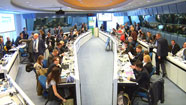On 5 April 2016 the JRC presented the interactive and collaborative online European Energy Efficiency Platform. This beta platform is conceived to fill the gap opened by scattered data and fragmented knowledge resulting from a rapidly growing energy efficiency market. It is expected to be both a one-stop shop for information retrieval and a meeting point for experts to exchange data and reduce redundant activities.
Energy Efficiency and GHG Emissions: Prospective Scenarios for the Aluminium Industry
Results from this recent JRC study show that, in 2050, the energy consumption and direct greenhouse gas (GHG) emissions of the European aluminium industry could be decreased by 21% and 66%, respectively, if the sector adopts innovative technological solutions instead of following a conservative technology deployment path. The primary aluminium production sector in particular could yield significant reductions of specific energy consumption and direct GHG emissions, 23% and 72%, respectively, between 2010 and 2050. These results show and quantify the potential for energy efficiency and GHG emission improvements in the European aluminium industry. The JRC analysed the current status of the aluminium industry in EU28 and Iceland by compiling a database of existing aluminium production facilities (33 facilities that included 9 bauxite refineries, 20 anode bakeries or anode paste plants and 26 smelters and casting plants), their production characteristics and the best available and innovative production technologies used, such as dynamic AC magnetic fields, wetted drained cathodes, inert anodes or carbon capture and storage (CCS). Subsequently, the energy consumption and GHG emission trends towards 2050 in each facility was analysed using a model based on detailed information at facility level for all facilities involved in primary aluminium production, and in a simplified fashion, in secondary aluminium production. The model identifies cost-effective improvements in aluminium production at facility level and the impact of their implementation on energy consumption and GHG emissions, based on the condition that investments are recovered within five years and on the assumption that there are no barriers to the timely commercialisation of the identified technological solutions. The analysis shows that most of the reductions come from technologies that are in early stages of research (e.g. inert anodes that are in a technology readiness level (TRL) 4 or 5 or CCS at even lower level). Therefore, realising this potential necessitates the creation of the right conditions that allow the further development and commercialisation of these innovative technologies.





To quote this publication use the follonwing format: